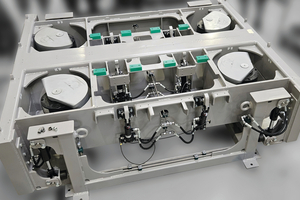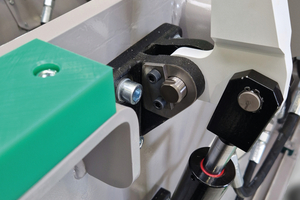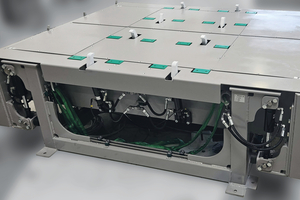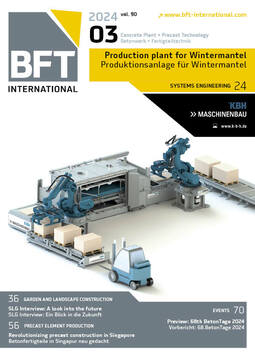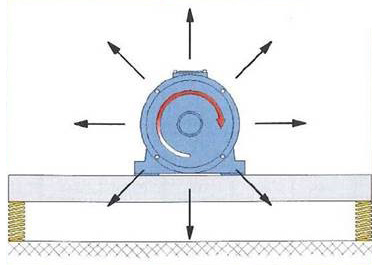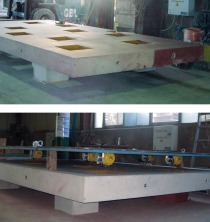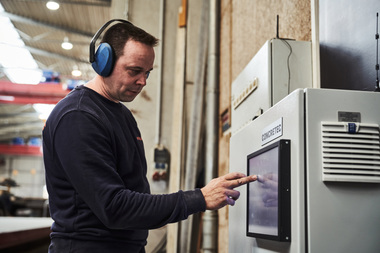Vibration technology optimizes production conditions in a precast concrete plant
The compaction and the formulation of concrete mixtures are among the most important influencing factors in the production of concrete elements. During compaction by vibration, periodic oscillations are introduced into the concrete.
This technique compacts the concrete and fills its cavities. Entrapped air can quickly rise to the surface and escape; greater strength and a finer surface structure are the results.
The project
In a European concrete plant, precast solutions for the manufacture of such products as fence and noise-protection elements have been employed for many decades. In this plant, the elements are manufactured on vibrating tables in formwork frames for the private and industrial sector, adapted to the customers’various requirements and design variants.
To meet the most important aspects of quality, sustainability and a long service life, the concrete elements manufactured here excel in robustness and aesthetics – which implies and requires zero porosity. Targeted expulsion of air bubbles and uniform distribution of the concrete mass in the form are essential for a low-porosity, dense concrete structure: prerequisites for durable, faultless concrete.
The customer operates with a fully automated rotation system on which forms are filled with concrete and subsequently transported to the vibrating table. The next station is a kiln for drying before the forms are demolded and loaded for shipment. The system that was previously used for a long time had only two vibrators and required shutdown between processing cycles – which resulted in economically inefficient start-up and shut-down cycles.
Implementation
This customer’s wishes and specifications are reflected in great detail in input of the dimensions of the forms to be used, as well as in integration of the GyroShake system from NetterVibration in the time-tested plants and processes in production and coordination of the interactions of the existing transport system.
In time-consuming and close collaboration with their customers, experienced engineers and technicians at NetterVibration have adapted a vibrating station of the GyroShake series to on-site conditions and specifications at the customer’s site, resulting in commissioning on location in late summer of 2023.
This was preceded by previous successful collaboration in other areas of production, as well as a pilot operation of many months on a plant that had been made available to the company on a rental basis. Intensive trial series were competently accompanied by experienced field staff from NetterVibration. A wide range of formulations had to be tested, adapted and/or refined, since the system requires a flowable consistency.
The System
The GyroShake vibrating system consists of a base frame, on which a freely oscillating frame is suspended from a pendulum system. This ensures loss-free deflection as well as optimized energy transmission. Compact vibrating drives with large imbalances enable compaction of high loads while ensuring especially nondamaging effects on the other components of the plant. For this reason, four powerful electric vibrators are arranged, as defined on the frame, and can be controlled up to 7 Hz in the low-frequency range.
Both frequency and amplitude are regulated while the plant is in operation, without the disadvantages of retooling periods, and without delays from start-up and shutdown cycles. The electric control system serves to select the parameters for the longitudinal and transverse movement (x and y axis), or for an additional circular movement (z axis).
GyroShake can be integrated into existing pallet rotation systems and is controlled by a master computer. The vibrating station is also successfully used in other areas of application such as in production of slab elements, garage floors, double-wall elements and railway ties. The enhanced process applicability of this solution, its great compaction performance for non-porous fair-faced concrete, as well as very low noise emissions all favorably convinced the customer and company staff.
Noise level reduction and longer maintenance intervals
High-frequency excitation and the resonance of materials emit enormous noise levels in the entire spectrum of mechanical engineering, especially in processing of steel molds. GyroShake operates with low frequency and greater amplitudes and therefore emits a reduced continuous sound level of below 70 dB(A).
Health and safety issues for the personnel at work in the immediate environment are of growing concern and are becoming an increasingly significant factor in weighting production facilities.
Low-frequency implementation in concrete compaction moreover effectively ensures less wear of the other components, which consequently extends the service life of the entire system measurably and means that maintenance is required less frequently.
Advantages of clamping the molds
Four hydraulic cylinders lift and lower the tabletop which serves at the same time as bearing for the oscillation and pendulum movements.
Clamping of the forms on the vibrating table ensures that the forms do not move or shift during compaction. To implement these central requirements of the customer, eight hydraulically operated clamping arms are extended in time with the processing cycle and simultaneously fix two forms on the table.
Keeping the forms from slipping, channels transfer the entire kinetic energy into the concrete and at the same time reduce production noise.
CONTACT
Netter GmbH
Fritz-Lenges-Straße 3
55252 Mainz-Kastel/Germany
+49 6134 2901-0

